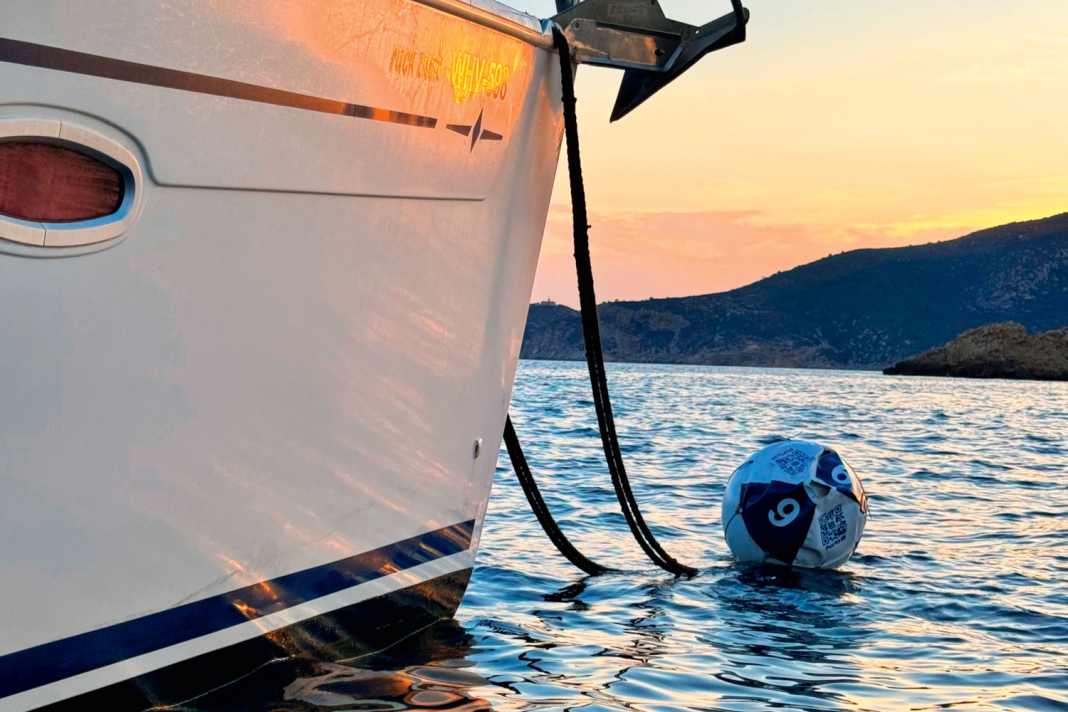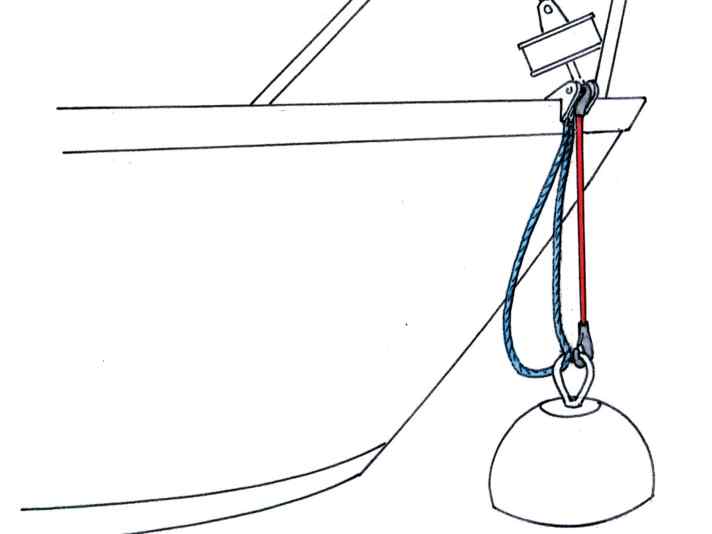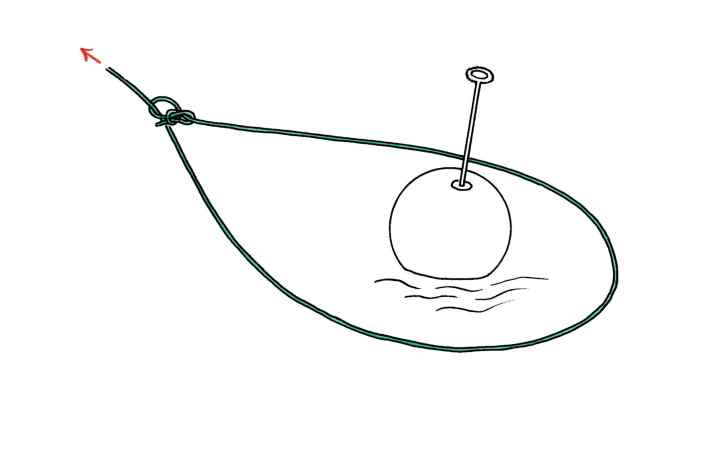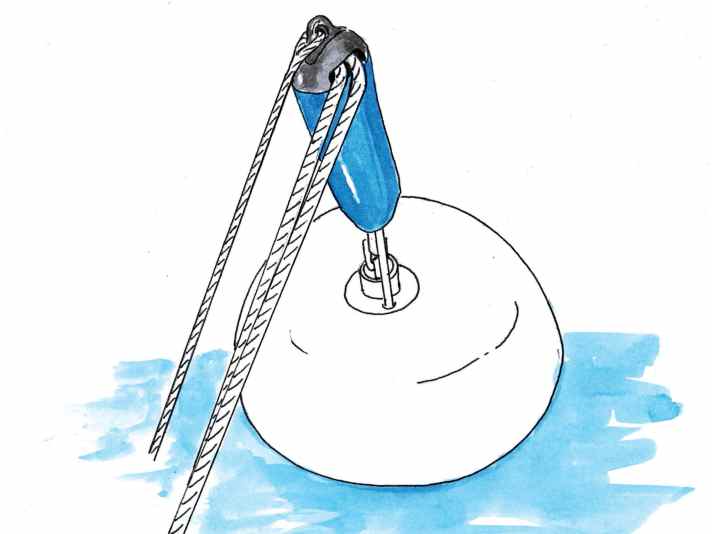





What could be nicer than dropping anchor in a secluded bay? It costs nothing, you lie quietly and you can watch the starry sky without any disturbing light. In practice, however, the most beautiful bays are often full of other anchors, which, to make matters worse, also have different behaviour. Your own ground anchor then falls with a queasy feeling or not at all. In any case, a good night's sleep is a thing of the past, and if the chain of a neighbouring boat is also grabbed the next morning while hauling up, then the debacle is perfect. For the next night, an overpriced mooring is again gratefully accepted.
A mooring buoy site consists of various components. The clearly visible floating body in the form of a buoy is located above the surface of the water. This is connected by a chain to the bottom gear, which lies on the seabed or is sometimes even buried. This is usually a submerged concrete block, but large disused anchors or ground screws can also serve as a fixed point. There are various ways of attaching the mooring lines to the buoy or pulling them through. This can be a cordage loop attached to the chain or an iron rod with an eyelet inserted through the buoy.
Components of the system
A mooring buoy site consists of various components. The clearly visible floating body in the form of a buoy is located above the surface of the water. This is connected by a chain to the ground tackle, which lies on the seabed or is sometimes even buried. This is usually a sunken concrete block, but disused large anchors or ground screws can also serve as a fixed point. There are various ways of attaching the mooring lines to the buoy or pulling them through. This can be a cordage loop attached to the chain or an iron rod with an eyelet inserted through the buoy.
Variants and operators
In our neighbouring country to the north, Dansk Sejlunion and Danske Tursejlere look after the 300 mooring buoys in Danish waters. As a paying member of a Danish club, all buoys can be used free of charge. The 150 Dansk Sejlunion buoys are marked with "DS".
German sailors can also register with Danske Tursejlere to access the entire network. Only the 150 mooring buoys marked with DT can be used free of charge by all sailors without any club membership. In the "Blå oplevelser" app, there is a map with all the buoys laid out and the exact coordinates. Tourist information on the respective area can also be obtained via a link, but only in Danish. The Danish buoys may not be occupied for longer than 24 hours and the maximum load of 15 tonnes may not be exceeded. However, several small boats can moor at one buoy as long as the maximum load is not exceeded. However, the operators are not liable for any damage even if the regulations are observed. The Danish mooring buoys are normally located in a water depth of 2.5 to three metres, which is why their use in onshore winds and possible grounding is officially discouraged.
There are now twelve buoy fields on the Balearic Islands, seven of which are publicly owned. These paid sites are primarily used to protect seagrass beds and can be booked on the website www.portsib.es can be booked. Only one boat per mooring buoy is permitted here and the maximum permitted wind force is 16 knots. The harbour authority offers buoys up to eight, twelve, 15, 20 and 25 metres in length. Catamarans have also been able to book since this year. The buoy fields are available from 13 June to the end of September, in some cases until 15 October. The sticking point: the boat must be registered before booking. In addition to personal details about the skipper and boat, a scan of the boat's papers must also be uploaded. In addition to four other buoy fields, which are managed by sailing clubs, there is also one in the Cabrera National Park, which must also be booked in advance.
There is also an anchoring alternative in Germany, such as in Eckernförde, where the Altona-Oevelgönne e.V. sailing club (SVAOe) operates a total of 36 mooring buoys. Yachts up to around 40 feet can moor there; non-club members pay between eleven and 14 euros for the night. To ensure that the ground tackle is always in perfect condition, it is inspected after each season, cleaned and replaced if necessary.
Useful aids for mooring to a mooring buoy
As the freeboard is highest at the bow and the mooring buoy is therefore more difficult to reach, it may make sense to approach it from the stern and use the bathing platform or ladder. This is especially true for solo skippers. The helmsman can also see the buoy better this way. Otherwise, the lines can also be easily passed through and returned from a dinghy. Ideally, one line should be attached to each of the two front cleats. A patent mooring hook is also a good aid for threading in the mooring line.
There are also disadvantages
The basic problem is that crews are often unable to check the condition of a submerged ground tackle. It helps to contact the operator, if known, and ask what weight the system is designed for and when the last maintenance work was carried out. Sometimes it also helps to take a dive to get an impression, or to perform a courageous reversing manoeuvre to test whether the mring delivers what it promises. If the mounts on the weight or the chain are badly corroded, the boat can be hanging by a thread, so to speak. So at the end of the day, it's always a question of trust whether you put yourself on someone else's chain. Another disadvantage, although not safety-related, is noticeable in calm conditions or unfavourable currents: Your own ship then regularly sails against the float, which leads to nerve-racking noises in the forward cabin. However, there are simple and effective tricks to prevent this.
In stronger winds and corresponding swell, a larger yacht is quite capable of lifting concrete slabs from the seabed. This is also confirmed by insurance expert Dirk Hilcken from industry leader Pantaenius: "We once had a case where a boat that had been hanging on to a fixed harness for a long period of time bounced across the bay of Alcúdia with the anchor stone. At some point, it was hanging on the breakwater and was scrap."
Duty of care of the skipper
The skipper is well advised to look out for obvious defects in the mooring buoy to minimise the risk of a broken mooring. "In order to fulfil his duty of care, he should always ensure that another person regularly checks the buoy and boat if he is away for a longer period of time. Even if a mooring buoy is rented for a short period of time, we recommend asking about the maintenance status to avoid any unpleasant surprises at the end," says Dirk Hilcken. In this way, the policyholder ensures that his insurance company cannot claim gross negligence in the event of a claim. In this case, the insurance company may refuse to pay benefits, at least in part.
The fact is that there are no legally binding guidelines on how a Muringtonne must be secured or which specify the dimensions of weight and chains. As a rule of thumb, the less secure the mooring appears to be, the more care needs to be taken with the boat - similar to anchoring. However, if the basic harness is well maintained and the boat is suitable for this, then in moderate weather conditions it can be assumed that the berth is not only comfortable but also safe.
Tips from YACHT readers
Sleep through the night thanks to the elasticated band

We hook a strong rubber band with a hook each to the mooring buoy and to the anchor fitting. This keeps the buoy in position close under the bow and prevents it from hitting the hull in calm conditions. When the wind picks up, the rubber band stretches and the mooring line holds the boat as usual. A short mooring line, on the other hand, would be uncomfortable. So we have calm nights in both calm and windy conditions.
Manfred Hofinger, Buchkirchen
More convenient access to the ring

We made an auxiliary buoy to get the boat back to the mooring buoy easily, even single-handed. A PVC pipe about 1.5 metres long is fitted with a fishing net buoy and secured with cable ties. The lower end of the pipe is weighted down with lead weight and a flag is tied to the top. The auxiliary buoy is attached to the eye of the mooring ring with a thin line and can be easily gripped from the deck.
Frank Sauer, Singapore
Mooring with the buoy lasso

We make mooring easier for ourselves with a sling. While the boat slowly passes the mooring buoy, the sling is thrown over the buoy and pulled tight. To cast off, two people use the boat hook to spread the sling so far that it can be pulled back over the buoy. The casting off manoeuvre is complete.
Otto Kalkbrenner, Graz/Austria
Fender against noise and scratches

We use an old fender to prevent the mooring pole from hitting the hull in calm conditions. The lower end is cut off so that the rubber sausage can be slid over the pole. A hole is cut at the top through which a line is pulled endlessly. We use a safety line to pull the fender down again after casting off.
Günter Löffler, Eckernförde

